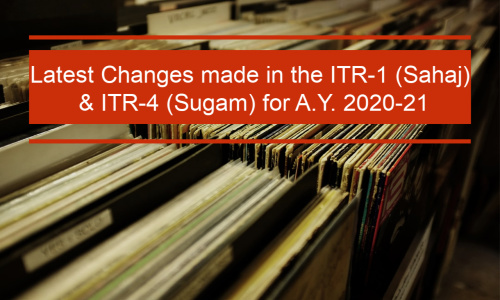Recently, the Central Board of Direct Taxes (CBDT) has notified two Income Tax Return (ITR) forms which shall be applicable for the assessment year 2020-21. Generally, as per the past experience, it is seen that the tax department issues the new ITR forms in the first week of April of the relevant assessment year. For example: In the case of FY 18-19, the ITR forms are issued in the first week of April of assessment year which is 19-20 i.e. 1st week of April 2019. However, as compared to an old tradition, the cheap iwc replica tax department has issued two ITR forms i.e. ITR-1 and ITR-4 for the assessment year 2020-21 in the first cheap cartier replica week of January 2020. These new forms have incorporated all the changes made in the last Finance Act i.e. finance act, 2018.

These newly notified ITR forms shall be applicable for the previous year 2019-20 or buy replica watches Assessment year 2020-21. In other words, in this form, an assessee shall be required to file the return by entering the details of the income earned from 01.04.2019 to 31.03.2020.
It might be possible that this is the first time when the government has notified the ITR forms itself in the previous year i.e. before the beginning of the relevant assessment year.
Note: Although the government has notified the ITR-1 and ITR-4 for the AY 2020-21 however the ITR utility in respect of these forms is yet to be issued. As we already know that the structure of new ITR-1 and 4 in the ITR utility shall remain the same, the number of changes in these ITR forms are several.
We will discuss in the form of FAQ of all the relevant changes brought for the assessment year 2020-21. So, let’s begin:
Q. 1 For which assessee, these forms are relevant?
ITR-1 or Sahaj form is the return form which is to be filed by the ordinarily resident individual whose total income does not exceed Rs. 50 Lakhs. Generally, these forms are being used by the salaries employed person whose annual salary is up to Rs. 50 Lakhs.
On the other hand, ITR-4 or Sugam form is the return which is meant for the resident individuals or HUFs or firms (other than LLP) whose total income is up to Rs 50 lakh and have chosen to pay the tax on presumptive income from business and profession.
Note: Where the assessee could not manage the financial records and unable to correctly compute his net profit and loss then the income tax has given an option to such assessee under which he can pay the tax on the specified percentage of his total turnover.
A person who is earning the income from the business then he shall be required to pay the tax @ 6% of his total turnover where his all receipts come from the banking channel and if he also received some cash through business then the said percentage shall be increased from 6% to 8%. In simple words, if the person is in some business having the income through cash, then he can choose to give the tax @ 8%.

However, it is noted that if a person has chosen to give the tax on a presumptive basis then he shall have to pay tax on a presumptive basis for the next 5 assessment years also. If in any assessment year, he has paid the tax as per the normal calculation, then he cannot avail the benefit for the payment of tax under the presumptive basis for the next 5 assessment years.
The said condition was made only for the person who is engaged in business. If an assessee who is earning the income from any profession then this condition shall not be applicable for him.
A person who is earning the income from Profession then he shall be required to pay the tax @ 6% of his total turnover.
Q. 2 What are the significant changes that have been brought in ITR-1 and ITR-4 this year?
Scope of ITR-1
As per the notification, individual taxpayers who are
- Owning a house property in the joint ownership and
- Those who have paid Rs 1 lakh or more in electricity bills in a year or
- Incurred Rs 2 lakh or more expenditure on foreign travel
He is not eligible to file his annual income return using the simple ITR-1 form.
The ITR-1 return form is not valid for those individuals assessee who has
- Deposited more than Rs 1 crore in a bank account or
- Have incurred Rs 2 lakh or more on foreign travel or
- Spend Rs 1 lakh or more electricity respectively.
Those assessees who fall in any of the above criteria, they have to file their return in any other form which shall be notified in any future dates.
As we already specified above that Return in ITR-1 and ITR-4 could not be filed by a person who owns a house property in joint-ownership
Such person, who were eligible to file return in ITR-1 or ITR-4 till last assessment year, falling in the above condition, will now have to file return in ITR-2 or ITR-3, as the case may be.
Further, the return in ITR-1 form cannot be filed by an individual who, during the financial year 2019-20, has received a notice pursuant to search proceedings
This condition was not in the return relevant for the assessment year 2019-20. That means, up to Assessment Year 2019-20, an individual taxpayer is eligible to file the ITR-1 return form even if he has been issued a notice by the Income-tax Department under section 153A or section 153C.
Section 153A explains about the provision in which the assessment of a person is being done after the search or requisition, whereas section 153C deals with the assessment of income of a person other than a person referred to in section 153A.
As per the new provision, the option to file the ITR-1 return form by the resident individual has been removed where the notice has been issued under section 153A or section 153C. Thus, where a notice under these sections has been issued to an individual taxpayer, such assessee shall be required to file ITR-2 only for the assessment year 2020-21.
Employer details in ITR-1 & ITR-4
The new notified ITR Forms ITR-1 & ITR-4 requires to provide the details of employer, i.e., Name of the Employer, nature of the employer, TAN of the employer, and address of employer if the taxpayer is taking his salary income, which was required only in ITR-2 and ITR-3 till last year.
Further, these new forms also provide an option to add more than one employer to determine the salary income. A taxpayer can even add multiple rows to determine the salary income received from more than one employer.
It is noted that the Existing ITR-1 and ITR-4 return forms which were applicable up to Assessment Year 2019-20, did not have such kind of functionality which requires the individual to mention the details of aggregate salary income received from multiple employers.
A Resident individuals who are having a valid passport will have to compulsorily mention the passport number
The New ITR-1 and ITR-4 return forms require the resident individual to provide the details of the passport having an Indian passport. The new forms have provided the following options:
- Do you have a valid Indian passport?
- If yes, provide the passport number
It is possible that the passport number is being asked by the department for a reason so that they can check whether the taxpayer has traveled to a foreign country in the financial year 2019-20 and whether his declared income can be matched with his ability to incur the expenses on such foreign travel. Also, if he traveled the foreign country and spend more than 1 Lakhs and still filed the ITR-1 and ITR-4 return then such return shall be treated as an invalid return.
Not only addition has been made, but rather there is some deletion also made in these returns. As now there will be no need to provide the details of unsecured loans, sundry debtors, sundry creditors, closing stock, etc, which was mandatory to be provided in past years.
Now, Let’s summarize all the significant changes:
- If a person is having a passport, then the passport number is required to be given
- If the assessee has spent more then Rs.2 Lakhs on foreign travel, then amount to be specified and could not file the ITR-1 or ITR-4.
- If the assessee has spent more then Rs.1 Lakhs on Electricity bill, then amount to be specified and could not file the ITR-1 or ITR-4.
- If the assessee owns the property in co-ownership then he cannot file the return in ITR-1 or ITR-4 form.
- If he has deposited Rs. 1 crore in one or more in current accounts then the aggregate of all amount to be specified in the return

